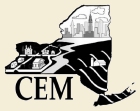CEM focuses on local conservation efforts. Typically local planning efforts
are focused on socio-economic concerns. Natural resources are often
examined, but not in detail or they are sometimes seen as impediments to local
progress. CEM attempts to shift our thinking from planning's impact on
conservation to conservation's impact on planning.
CEM facilitates this shift by offering a wide range of strategies and
management options for conservation at the local level. These strategies and
options have been tested in diverse settings and are proven to be effective.
Some communities may have already outlined these strategies and options as
part of other initiatives, but lack the guidance and resources to properly
implement them.
Working with a diverse group of partners, the CEM initiative attempts to
streamline, manage and guide conservation efforts into effective local programs.
None of the strategies and options recommended are new. CEM is simply a
process. This process builds on the communities existing strengths and attempts
to provide viable alternatives for addressing weaknesses and can improve
connections to existing resources that are available to help.
The goals of the CEM process are as follows:
- Local leaders will develop an increased understanding of why education and public outreach are important to conservation issues and practices.
- Key personnel and decision-makers involved in natural resource and water quality management will be identified and invited to participate in the CEM process.
- Local leaders will gain a more realistic evaluation of existing municipal and watershed conditions.
- Local leaders will be exposed to a variety of different strategies and management options that address conservation concerns.
- Existing sources of community assistance will be identified and exploited.
- Example conservation initiatives will be provided highlighting their structure and overall benefits.
- Conservation and natural resource plans will be developed that are tailored with specific municipal and watershed resources/issues in mind.
- Conservation and natural resource plans will be integrated with existing planning efforts to ensure their support and implementation.
- Local support for conservation initiatives will be increased.
- Municipalities or watersheds will benefit socially and environmentally from the implementation of effective and efficient local conservation programs.
CEM is loosely organized into five tiers. Does that mean that every initiative or individual project will go through all five tiers? Not necessarily. If you
were working long-term with a municipality or other group, you would most likely
go through all five tiers. There maybe times when only very specific issues need
to be addressed through CEM and only one of two worksheets get reviewed.
There may be opportunities to impact master plans, create conservation zones
or assist in conservation sub-division development or there may be opportunities
to provide limited technical assistance and ideas. Whatever the depth and scope
of your CEM initiative / CEM involvement is, there are real opportunities to bring
about positive change to the way we perceive and manage our natural resources
and water quality.
There are also many potential benefits and opportunities for the group or
individuals involved with a CEM initiative or project. Here is a brief listing:
- Broadened & strengthened support for the groups and individuals involved
- A chance to work on the "Big Picture"
- Broadened Potential Funding Sources
- A chance to treat the “disease” rather than fighting symptoms
- Improved visibility and credibility in municipality, watershed and/or county
- Increased on the ground efforts
- A chance to use pervious developed data, protocols and strategies
- An opportunity to shift municipal, watershed and/or county’s focus and priorities on environmental issues
- Better integration of plans and actions
- A chance to have a stronger voice within the state
|
